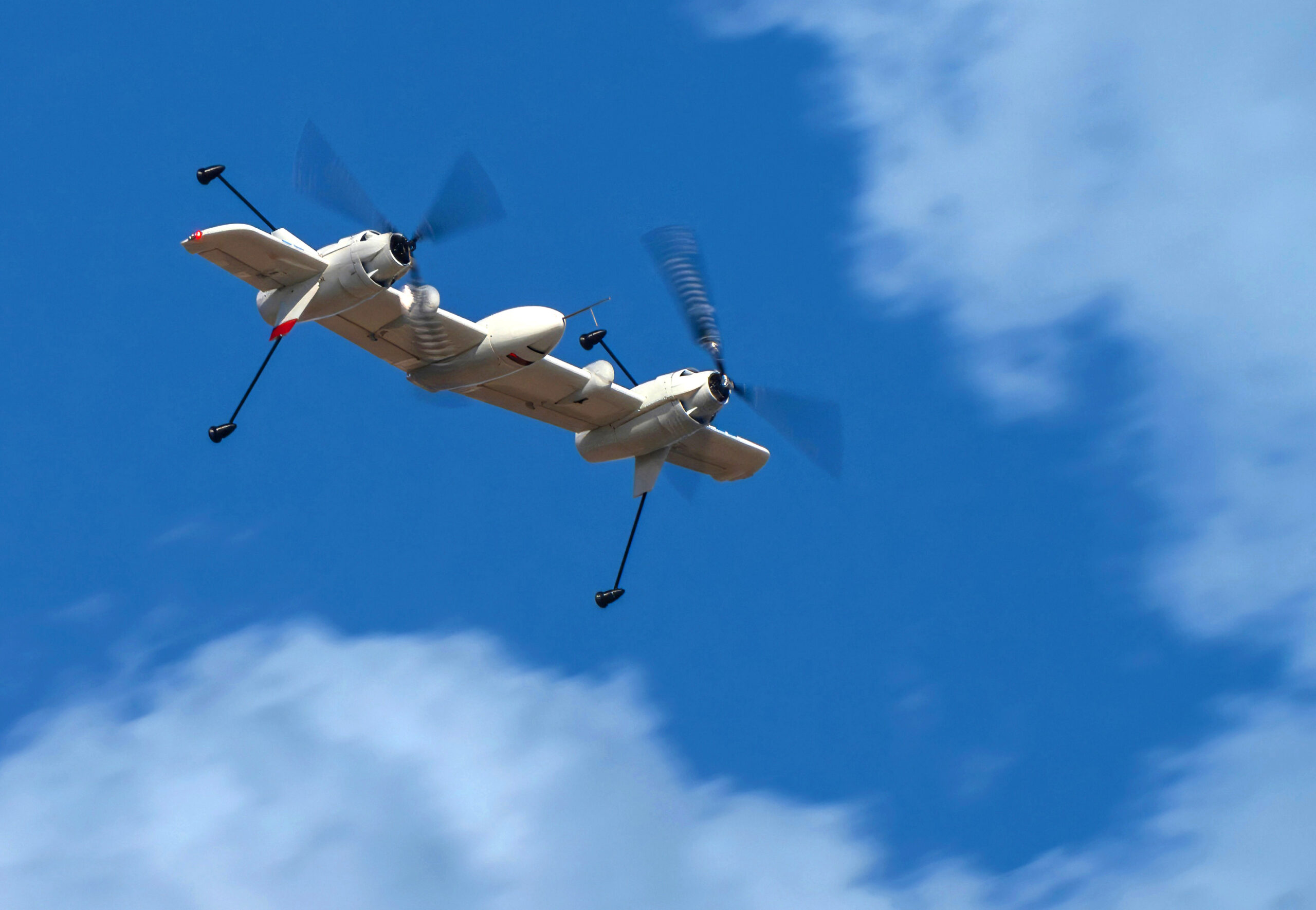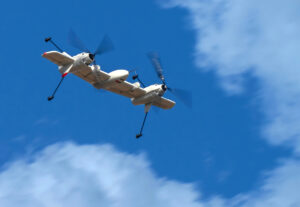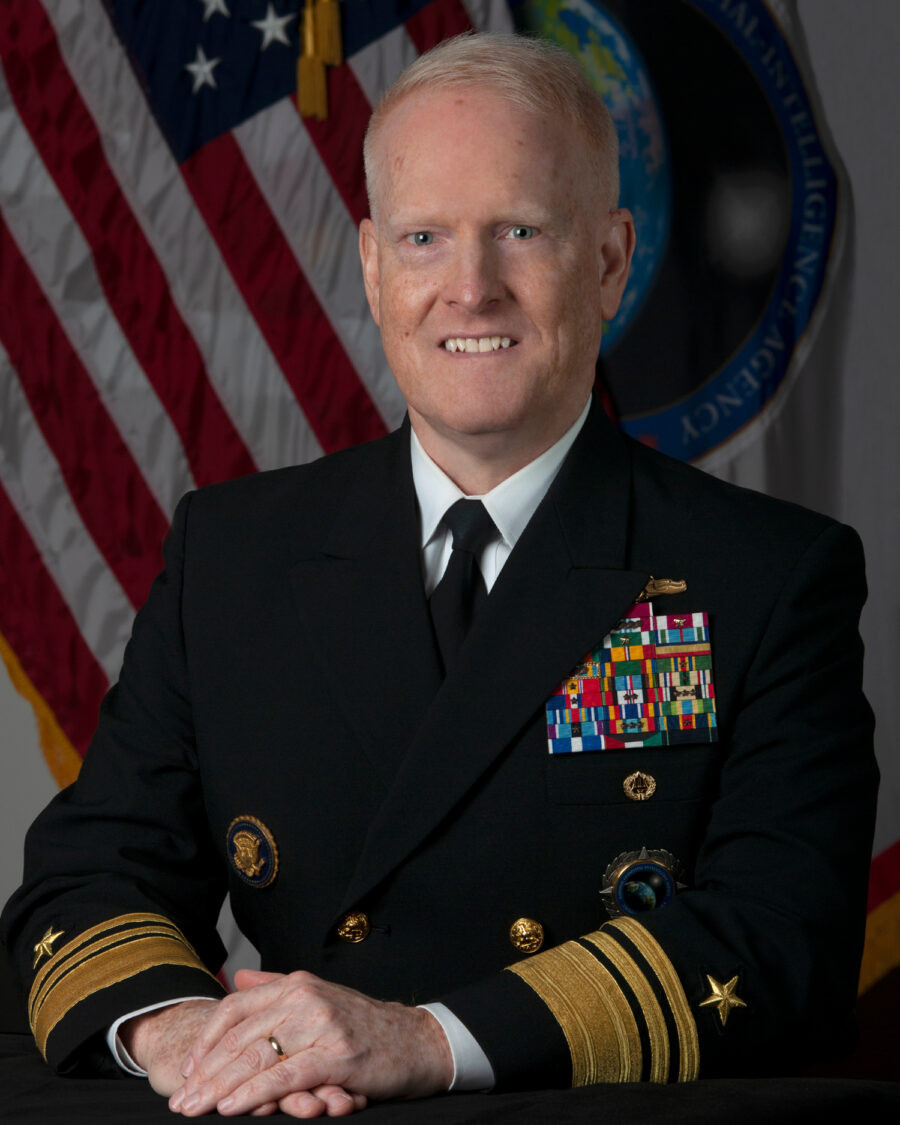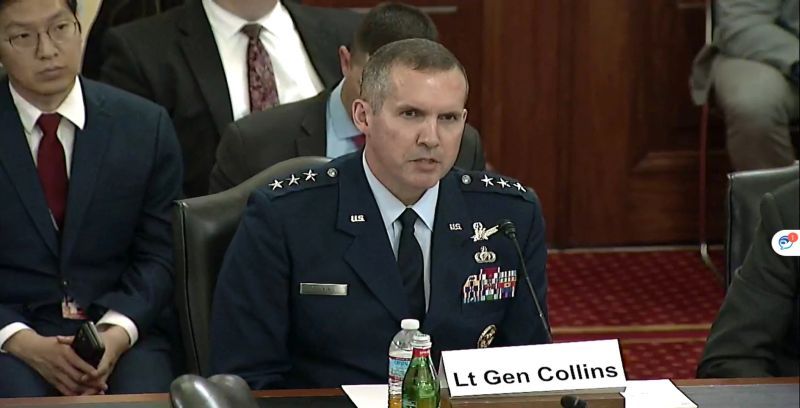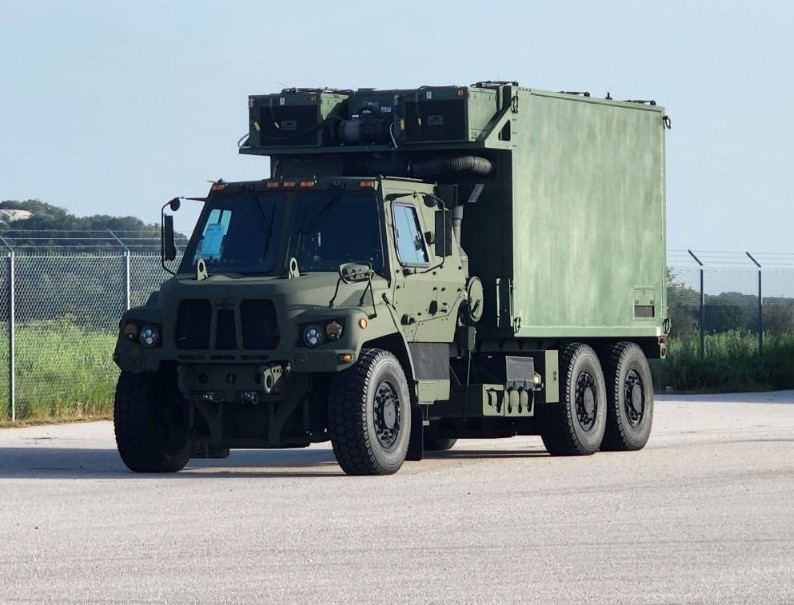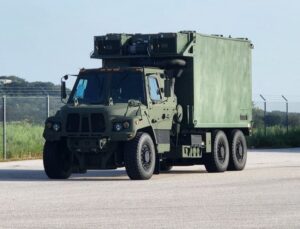Static Fire. The U.S. Air Force said that the service and Northrop Grumman conducted “a full-scale qualification static fire test of the Sentinel intercontinental ballistic missile [ICBM] stage-one solid rocket motor” on Thursday at Northrop Grumman’s site in Promontory, Utah. The company is building the LGM-35A Sentinel ICBM to replace the Minuteman III ICBM. “This critical milestone further validates the motor’s design and paves the way for the production and deployment of a safe, secure and reliable strategic deterrent,” according to the Air Force Nuclear Weapons Center at Kirtland AFB, N.M. “This test confirms the accuracy of digital engineering models and brings the stage-one solid rocket motor closer to achieving full qualification. This achievement follows static fire tests of the second and third stages, showcasing clear momentum in the Sentinel program’s development…The test results are currently being analyzed by a team of experts from the Air Force Nuclear Weapons Center and Northrop Grumman.” On Jan. 18 last year, the Air Force said that it notified Congress that Sentinel had breached Nunn-McCurdy guidelines, primarily due to construction design changes. The program has continued, but last summer DoD pulled Sentinel back from the engineering and manufacturing development stage, which the Pentagon had approved for the next generation ICBM in 2020.
…Weapon System Review.
Future nuclear command, control, and communications (NC3) is to share some commonality with other systems developed under the command, control and communications battle management (C3BM) effort of Air Force Maj. Gen. Luke Cropsey, the Air Force program executive officer (PEO) for C3BM, even though NC3 is a separate development under the Air Force PEO for NC3, Scott Hardiman, at Hanscom AFB, Mass. “Very early on, Gen. Cropsey’s team and Mr. Hardiman’s team realized that there needs to be synergies, and we need to have as much commonality as possible,” Air Force Lt. Gen. Andrew Gebara, the service’s deputy chief of staff for strategic deterrence and nuclear integration, said on March 5. “They routinely talk to each other, and they are not architecting anything that could not, at some point, be connected… Just last week, I believe, Air Force Global Strike Command did a weapon system review of NC3. There were C3BM teammates watching that. That commonality is very important, as we go to that future architecture, based on the threats that we see today.”
Bomber Close Air Support. Two U.S. Air Force B-52H Stratofortresses and two Italian Air Force Eurofighter Typhoon fighters practiced close air support missions with Italian troops on Friday in the SPARTAN MACE exercise, according to U.S. Air Forces Europe (USAFE). Under the U.S. Air Force Bomber Task Force (BTF) 25-2 deployment, the B-52s, escorted by the Eurofigher Typhoons, “entered an Italian military range near Sardinia Island, where they conducted simulated live bomb drops under the guidance of Italian Joint Terminal Attack Controllers,” USAFE said. “The mission reinforced coordination between air and ground units, refining precision strike capabilities in a complex training environment. The B-52s and aircrew are currently deployed with the 69th Expeditionary Bomb Squadron at RAF Fairford, England, where they are executing operations alongside NATO Allies and partners…SPARTAN MACE marks the tenth operation integrating U.S. B-52s with allied air and ground forces during this BTF 25-2.”
3-D Printed Carrier. HII said on March 4 that it installed the first valve manifold assembly built via additive manufacturing onto a future USS Enterprise (CVN-80) Ford-class aircraft carrier. The company boasted that using certified 3D-printed parts like this could accelerate construction by reducing lead times and improving manufacturing quality of critical components. This specialized assembly allows distribution of a single source of fluid to multiple points on a ship and is installed in a pump room on the carrier. The assembly is about five feet long and 1,000 pounds. HII’s Newport News Shipbuilding worked with DM3D Technology to manufacture the manifold body. HII next plans to install similar manifolds on the future USS Doris Miller (CVN-81)
NSMV V. TOTE Services LLC and Hanwha Phully Shipyard, Inc. marked the keel laying of the fifth and last of the National Security Multi-Mission Vessels (NSMV) on March 5. The NSMV program is designed to provide training for future American mariners and double as supporting humanitarian assistance and disaster relief missions. The program was commissioned by the Department of Transportation Maritime Administration (MARAD). The first two NSMVs, the Empire State and Patriot State, have been delivered while the third is scheduled for delivery later this year. The companies boasted the Vessel Construction Manager acquisition model used in the program allowed all five vessels to have had their keels laid in the last 39 months. These vessels include advanced training facilities, fully equipped bridge, and accommodation for up to 600 cadets and 100 faculty.
Secret Guam Challenges. The Government Accountability Office on Feb. 28 published a classified report titled “Missile Defense: DoD Faces Support and Coordination Challenges for the Defense of Guam.” The office website notes this means it was determined it contains classified information so cannot be publicly released, but the listing lets Congress, agencies and the public know it exists.
Seahawks Down Under. The Australian Minister for Defense Industry on Feb. 28 announced the government awarded a $197 million contract to Sikorsky Australia for through-life maintenance of the military’s 23 MH-60R Seahawk helicopters. Pat Conroy, Minister for Defence Industry and Capability Delivery, noted the investment will create 75 “well-paid jobs and support another 200 jobs for locals in Nowra, Australia. The company already employs 200 people at the facility. Conroy noted in a press conference Australia expects another 13 helicopters to be delivered by the end of 2026, which will also be serviced at the facility.
…Future U.S. Support? The ministry also said this funding is helping make Nowra a potential maintenance hub that could be used by the U.S. Navy for repair, overhaul and upgrade support. “This contract also means that if the United States Navy requires maintenance, repair overhaul, and upgrade support for their Sea Hawk helicopters in the Indo‑Pacific we can do that work here if needed,” Conroy said in a press conference. Previously in 2023 the Nowra facility completed the first deep-level maintenance of a U.S. Navy MH-60R.
Navy AI Test. The Navy on March 5 issued a Request for Information/Submissions for respondents hoping to be considered for participation in the DoD’s RAITE 25, a red/blue team test event for Artificial Intelligence (AI) and autonomy technologies on a cyber-physical range. RAITE is meant to provide academia, industry and government a real-time collaborative environment to test AI capabilities in terms of attacks and defenses to find technology gaps. Naval Surface Warfare Center, Crane Division (NSWC Crane), issued the RFI in support of the Chief Digital and Artificial Intelligence Office (CDAO). NSWC Crane said this will require the combined effort of industry, academia and government experts “to bring innovative initiatives into the experimentation event to achieve definable specific outcomes.” RAITE began in 2023 and the 2025 event will support scenarios including multimodal data (computer vision, radar, e.g.), cyber-enabled AI networks (such as critical infrastructure), UxV collaboration and environment interaction, and for the first time use Large Language Model Test & Evaluation as a dedicated scenario.
DDG Voice Comms. Leonardo DRS, Inc. on March 6 announced it delivered the first next-generation Integrated Voice Communication Systems (IVCS) for Arleigh Burke-class destroyers. The computer-controlled telephone system provides ship-wide communications. It connects to a ship’s announcing system, shore telephone lines, radio communications and battle sound-powered telephone circuits, the company said.
C-UAS Demo. Allen Control Systems will demonstrate its Bullfrog counter-drone robotic gun system at this year’s Joint Counter-Small Unmanned Aircraft System demonstration. Bullfrog is designed to defeat Group 1 and 2, and small Group 3 UAS autonomously using its passive machine vision detection technology integrated into an M240 machine gun turret to target low flying drones. The Texas-based company showcased its technology last August at the Defense Department’s Technology Readiness Experimentation—or T-REX—event at Camp Atterbury, Ind.
Expanding Partnership. Epirus and General Dynamics are looking to integrate the former’s Leonidas high-power microwave system aboard GD’s Tracked Robot 10-ton (TRX) combat vehicle to bring counter-drone and counter-electronic capability to highly mobile ground forces and to help secure borders and critical infrastructures, Andy Lowery, Epirus’s CEO, told Defense Daily last week. The companies have already done the design work for the full-scale integration where the TRX would be able to power Leonidas while driving along at 45 miles per hour in the vanguard of Army forces, “knocking systems offline, knocking down missiles, knocking off things in the front” to allow troops to more safely follow, he said. The companies have already demonstrated Leonidas on GD’s Stryker wheeled combat vehicle, and GD is considered a major investor in Epirus.
Constructive ADAIR Wingman. Top Aces Corp., which operates F-16 aircraft for air combat training, last week announced a proprietary artificial intelligence-powered autonomous constructive wingman for adversary air (ADAIR) training. The AI technology is supplied by Applied Intuition’s EpiSci unit and the constructive wingman was integrated by Coherent Technical Services into Top Aces’ F-16 advanced aggressor fighters. The open architecture Advanced Aggressor Mission System “hands-on throttle and stick interface allows Top Aces’ pilots to direct constructive wingman formations and maneuvers, coordinating them with the company’s F-16s to provide additional beyond visual range targeting challenges for 5th generation fighter pilots,” Top Aces said last week.
Leaving Antarctica. The Coast Guard’s Polar Star heavy icebreaker and crew on March 4 departed the Antarctic region after 65 days south of the Antarctic Circle in support of Operation Deep Freeze, an annual resupply mission to support the National Science Foundation at McMurdo Station. The icebreaker cuts a channel for resupply vessels. The Coast Guard’s lone heavy polar icebreaker departed its Seattle homeport last November and made stops in Honolulu and Sydney, Australia, before sailing to McMurdo Station.
GD Hikes Dividend. General Dynamics’ board last week increased the quarterly dividend nearly 6 percent to $1.50 per share payable May 9. The current dividend is $1.42 per share.
Maven Use Case. Contracting personnel working for a brigade subordinate to the Army Mission and Installation Contracting Command used a simulation of the Maven Smart System tool that uses computer vision to rapidly analyze imagery for potential targets to gain to gain situational awareness for planning contracting support of a warfighter exercise at Fort Bragg, N.C., in January and February, the Army said this month. “Maven provided continuous visual representation of contracted capabilities at the division and corps support area levels across all operational phases, including reception, staging, onward movement and integration, theater opening, theater distribution and theater sustainment, to fully support all aspects of the large-scale combat operations,” Lt. Col. Aditya Khurana, who helped oversee contingency contracting operations, said.
People News. The Senate last Thursday voted 53 to 43 to confirm Troy Edgar as Deputy Secretary of Homeland Security. Edgar served during the first Trump administration as chief financial officer and associate deputy under secretary for management at DHS. U.S. Central Command in late February named Joy Shanaberger as its new chief technology officer, replacing Sky Moore, who is in the Navy Reserves and was mobilized to serve overseas. Shanaberger most recently served as a senior adviser in the Office of the Secretary of Defense. Finally, Young Bang, who was principal deputy assistant secretary of the Army for acquisition, logistics, and technology during the Biden administration, has been appointed chairman of the newly formed strategic advisory board of Safe Pro Group. Safe Pro develops artificial intelligence solutions focused on drone imagery processing using commercial unmanned aircraft systems to rapidly identify explosive threats.
Defense Modernization Caucus. Reps. Rob Wittman (R-Va.) and Pat Ryan (D-N.Y.) will continue leading the bipartisan House Defense Modernization caucus for the 119th Congress, the lawmakers said this week. Wittman and Ryan, who both sit on the Armed Services Committee, said the group aims to “continue their efforts to advance the national security ecosystem through the integration and adoption of emergent technologies.” The two lawmakers launched the caucus last March, stating its goal is to serve as a “a driving force behind key policy and funding initiatives aimed at modernizing the U.S. Department of Defense and strengthening national security.”
Directed Energy. Parsons Corporation said on March 3 it has signed a Cooperative Research and Development Agreement (CRADA) with the Air Force Civil Engineer Center, Readiness Directorate to integrate its ZEUS 4 directed energy system onto the Joint Light Tactical Vehicle (JLTV). The CRADA builds on Parsons’ previous work integrating the earlier ZEUS 3 capability onto Mine-Resistant Ambush Protected (MRAP) vehicles for the Recovery of Airbase Denied by Ordnance (RADBO) program. “Integrating a ZEUS 4 system on a JLTV enhances operational flexibility and mobility for the Air Force. It allows for rapid deployment in diverse mission scenarios while maintaining a lower profile than larger MRAP vehicles. Additionally, the JLTV’s advanced technology and lighter weight facilitate improved power management and better integration of directed energy capabilities, ultimately increasing overall mission effectiveness and adaptability on the battlefield,” Parsons said in a statement.
Social Science Research. The Office of the Secretary of Defense for Research and Engineering is canceling its portfolio of social science research efforts “to ensure fiscal responsibility and prioritize mission-critical activities,” the Pentagon said on March 7. The move is expected to discontinue 91 studies and save $30 million in the first year, according to DoD. “This initiative involves focusing resources on technologies essential for maintaining a strong national defense, aligning with the administration’s commitment to efficient government and ensuring taxpayer dollars are spent wisely,” the Pentagon said. “Secretary of Defense Hegseth has emphasized the importance of equipping the American military with the tools and capabilities necessary to deter adversaries and maintain a strong defense. This initiative directly supports that commitment by prioritizing investments in areas like hypersonic weapons development, AI-powered systems for enhanced battlefield awareness, and strengthening the domestic military industrial base.” The Pentagon cited studies focused “on global migration patterns, climate change impacts and social trends” as examples of studies that will be scrapped.

